Coreca
Coreca (Coraca or Corica, in the local dialect variant) is a frazione of the comune (municipality) of Amantea, in the province of Cosenza, Calabria, Italy, located close to Campora San Giovanni.
Coreca | |
|---|---|
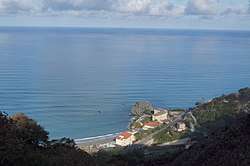 | |
 Coreca Location of Coreca in Italy | |
| Coordinates: 39°4′5″N 16°5′38″E | |
| Country | |
| Region | Calabria |
| Province | Cosenza (CS) |
| Comune | Amantea |
| Area | |
| • Total | 4 km2 (2 sq mi) |
| Elevation | 18 m (59 ft) |
| Population (1 January 2017) | |
| • Total | 700 |
| • Density | 180/km2 (450/sq mi) |
| Demonym(s) | Corachesi (in English) Corachese |
| Time zone | UTC+1 (CET) |
| • Summer (DST) | UTC+2 (CEST) |
| Postal code | 87032 |
| Dialing code | 0982 |
| Patron saint | Our Lady of the Angels |
| Saint day | 22 August |
Geography
Borders and territory
The southern Tyrrhenian Sea is to the west of Coreca, and the city of Amantea is to the south, where the border starts at Campora San Giovanni. The territory consists mainly of a rocky promontory, and the city center lies in the plain. It also includes a hilly area and wide beaches. The climate is typically Mediterranean, characterized by mild and humid winters and hot, dry and windy summers with a high percentage of sunny days.
Economy
The primary source of wealth in Coreca, as well as in nearby Campora San Giovanni, is the tourism and hotel sector, developed thanks to the scenic coastline: popular are the Coreca Reefs, photographed since the 1960s and used by amateur radio enthusiasts. There are also some small factories where food, furniture and machinery are manufactured.
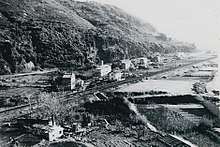
Hamlets
From 2017 the territory of Coreca is divided into the following hamlets:
|
|
|
History
In antiquity, when the first Greek Corinthian settlers arrived, they named the place Κόρακας (Korakas), which means the place of the crows "because of the luxanyante reminiscent of the native Corinth and its many crows. But in the region there was no autonomous human settlement, but a sort of stopover with a small port, named Ager Caricum in Roman times and so designated on some maps until the early eighteenth century. This stopover is on the roads between Temesa and Terina for the Aeolian Islands - in fact the islands are located 65 miles from the coast of Coreca. Ager Caricum gave the old name in Corica2 dialect. The place remains a lookout point over the centuries, but does not develop, leaving the nearby Amantea and nearby hill towns like Aiello Calabro and Lago to get tired.
The population comes down in part from some families from neighboring villages who have come since 1800 to settle in the current location.
In 1943, Coreca was a strategic point for Allied operations, especially thanks to the Turriella, a fort of Arab-Norman origin, used by Anglo-Americans for Morse signaling operations. The current name comes from the Coreca Anglicization. The Tonnara gatehouse, nowadays in ruins, was of strategic importance.
In the fifties, given the shortage of work and the misery of the post-war period, the inhabitants emigrated to Venezuela in the hope of a better future and a return to their native country. In the sixties, thanks to the economic boom and the revival of the Italian economy, Coreca is a tourist destination and for radio amateurs thanks to the privileged location of the rocks.
On May 20, 1974, because of tourism, the locality has been promoted by presidential decree to the status of frazione.
In the early 1990s, Coreca began to decline. The lack of relevance of various facilities and services, favoring the nearby Campora San Giovanni and the municipal capital. In 2008, the frazione annexed by municipal decree the territory of Marinella, Oliva and Stritture, and expanded in size from 2.5 square kilometres (0.97 sq mi) to 4 square kilometres (1.5 sq mi) .
A private broadcaster (Radio Coreca), one of the first pioneers of private broadcasting, lasted a short time and closed in 1996.
Beginning in 2013, a slow but excellent revival and awareness began to resuscitate Coreca, thanks also to local youth and other cultural associations in support of Coreca.
Monuments and places of interest
Church of Our Lady of the Angels
On October 1, 1964, work began on the construction of the Church of Coreca, which is be dedicated to Our Lady of the Angels, the work ending in 1965 in the presence of the authorities of the time. The church is of modern but sober style, able to hold 65 people. Every year during the patronal feast (August 22) there is a procession through the central streets.
Square Madonna degli Angeli
On April 2, 2003, the municipal resolution was passed and on 5 May 2005, the works began for the construction of the central square in order to host the summer events of the hamlet. Since 2015 it is named after of Madonna degli Angeli for the proximity to the little church and also for the presence of a small niche with a statue of Our Lady. The square is handled, cleaned and maintained in a communal use by a local tourist association since 2013.
Coreca's Caves
The iron mines of ancient Temesa are very important in the area. During World War II they were used as a refuge for local residents and for Anglo-American soldiers who used them as warehouses. Later the caves were used for Christmas and Easter events until the early 2000s.
Tower of Coreca or "Turriella"
Tower of Coreca is located north of the village of Coreca, on the slopes of the Tuvulo hill. This tower, partly collapsed on the first floor, is of some historical importance. It is perceived as a crucible of styles that have been followed over the centuries and used mainly as a view of the Arabs, then Normans and various lords of the territory followed up to the arrival of Nazi troops and then Anglo-American troops in the Second World War. Turriella can be reached by the Tonnara road to the north and the road from Marinella to the south.
Photogallery
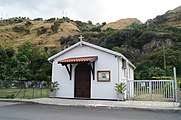 Church of Our Lady of the Angels in Coreca
Church of Our Lady of the Angels in Coreca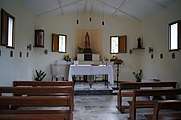 Interior of the Coreca Church
Interior of the Coreca Church Statue of Our Lady of the Angels in Coreca
Statue of Our Lady of the Angels in Coreca- The square of Coreca in an evening view
 The Coreca's Square in a panoramic night view
The Coreca's Square in a panoramic night view The tower "Turriella"
The tower "Turriella" The Coreca's Bay
The Coreca's Bay Coreca Beach seen from La Scogliera
Coreca Beach seen from La Scogliera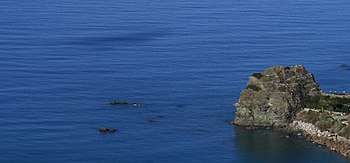 Coreca's Reefs
Coreca's Reefs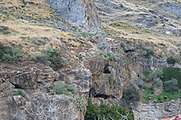 Coreca Cave
Coreca Cave Salto da Zita (Bride's Jump)
Salto da Zita (Bride's Jump)
References
External links
![]()